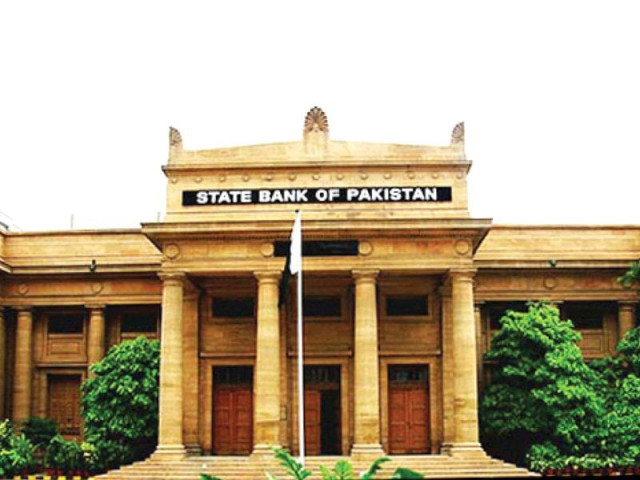SBP’s ‘outdated’ data raises questions
Central bank cites pre-flooding projections in annual report

The central bank has reported pre-flooding ‘outdated’ projections in its latest outlook section of the annual report on the State of Pakistan's Economy for the Fiscal Year 2021-22, saying the country’s growth would remain "below the previously announced range of 3%-4% for FY23”.
However, the State Bank of Pakistan (SBP) had revised down its economic growth to 2% for the year last month.
Earlier, the bank had projected an economic growth in the range of 3%-4% before the recent widespread floods struck the country.
A number of financial experts, however, expect the economic growth may fall well below 2% this year, considering the prolonged administrative controls on imports, high inflation readings, low foreign exchange reserves, and unsustainable external debt.
Similarly, the bank has reported an outdated projection for the current account deficit (CAD) for the year in the annual report. "The SBP projects [the] CAD to fall below last year’s level of 4.6% of GDP in FY23,” it read.
To recall, the SBP had projected the CAD at 3% (around $10 billion) in its latest monetary policy statement issued last month.
Thirdly, it reported the obsolete projection for the inflation reading in the current fiscal year as well. It has given the pre-flooding inflation expectation in the range of 18%-20% for the year in the annual report.
Last month, the central bank had revised up its inflation projection to 21%-23%.
The SBP said in the annual report that the recent widespread floods had multiplied the incumbent government's measures to cool down the then overheated economy, leading the way for economic growth decelerating below 3-4% in the current fiscal year 2023.
This figure is in stark comparison with the 6% recorded in the previous fiscal year 2022.
“Pakistan’s economic growth is expected to moderate considerably during FY23," the bank said.
As suggested by the tapering sales of high frequency demand indicators, the demand compression measures introduced by the government and SBP have started to cool down the overheated economy in the initial months of FY23. "The economy was already in a stabilisation phase, when widescale flooding hit a large part of the country [at] the start of FY23,” the report added.
The flooding in FY23 is likely to impinge on the country’s real economic activity through various channels.
Specifically, the losses in the agricultural sector emerging from the damages to crops and livestock are likely to transmit to the rest of the economy through various backward and forward linkages.
Similarly, the widescale destruction of the infrastructure in the affected provinces might also undermine the country’s growth prospects during the year, according to the annual report.
Supply shocks in the form of the rollback of energy subsidies and resumption of fuel taxation in addition to losses to the agricultural produce caused by floods are likely to influence the inflation trajectory during the year.
The elimination of subsidies and increase in fuel taxation triggered a sharp increase in inflation since June 2022, and the trend is likely to persist in FY23. Similarly, the supply shortages of perishable food commodities stemming from floods is expected to add further stimulus to prices.
On the other hand, the stabilisation policies introduced since last year and flood-induced losses to incomes might suppress the magnitude of demand-pull inflation during the year, the central bank said.
The widening of the tax base -- through elimination of exemptions, increase in their rates and reinstatement of fuel duty -- is expected to boost receipts during FY23.
The non-tax revenues will also recover with the re-imposition of the petroleum development levy (PDL) on the expenditure side and the rationalisation of subsidies is likely to keep current spending under check.
The coordinated fiscal and monetary policy stance is likely to reduce external account pressures in FY23.
The SBP projected the CAD to fall below last year’s level of 4.6% GDP in FY23.
This improvement would be driven by a sizable contraction in import growth.
As evident from the year-on-year declines in imports since July 2022, a range of demand compression measures introduced since last year have succeeded in trimming their growth momentum.
However, the losses to agricultural produce, induced by the recent floods, are likely to step up import of farm commodities, particularly cotton.
The slowdown in global demand might also weaken the exports growth during FY23 and policy tightening in advanced economies would dampen the prospects of capital flows to emerging and developing economies.
The workers’ remittances after witnessing a spike in FY21 appear to have plateaued in FY22 and are likely to remain at around the similar level in FY23.
The windfall gain from oil prices in the Gulf Cooperation Council (GCC) countries offers an upside risk to this projection.
Moreover, with the resumption of the International Monetary Fund (IMF) programme, the outlook of financial account has also improved.
Alongside the IMF programme disbursements, the country is expected to receive external financing from multilateral and bilateral creditors that will considerably strengthen foreign reserves position during FY23.



















COMMENTS
Comments are moderated and generally will be posted if they are on-topic and not abusive.
For more information, please see our Comments FAQ